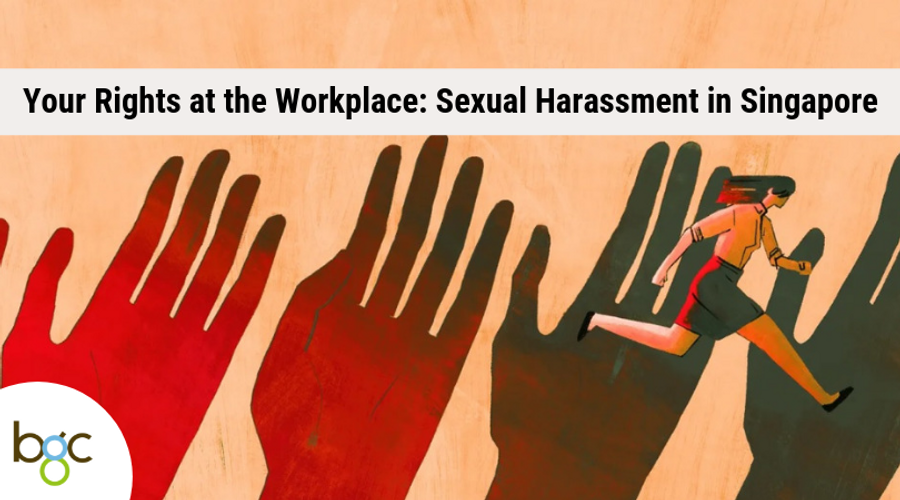Sexual harassment is an issue that is not frequently talked about in Singapore until the recent NUS case involving Monica Baey and Nicholas Lim went viral on Facebook. However, these sexual harassment cases are not one-off anomalies.
In fact, Singapore’s Association of Women for Action & Research (AWARE) reported that at least 54.4% out of 500 Singaporean women surveyed reported experiencing some form of sexual harassment in the workplace. Additionally, 66.6% of employees are not aware of the mechanisms to counteract sexual harassment within the workplace. What this means is that sexual harassment is still existent and human resource professionals, as well as employees, need to be better equipped to handle such situations.
Direct employers and manpower outsourcing agencies alike are now recognizing the importance of having policies and guidelines to protect their employees from such harm. To the best of their abilities, responsible companies are those who are committed to providing employees with a safe work environment that is free from discrimination and unlawful harassment.
1. What can be defined as workplace sexual harassment?

According to Asia Law Network, what constitutes sexual harassment and workplace sexual harassment is not yet well defined in Singapore. To get a better understanding of definitions at BGC Group for this article, Weilis, our Assistant HR Manager refers to workplace sexual harassment as acts that are felt as unwelcome advancements which cause distress to the employee.
At BGC Group, workplace sexual harassment is a broad term that covers even suggestive verbal or written comments, unwelcome physical acts, crossing unacceptable touch boundaries, to the even the more troubling forms of coercion for sexual favours. The unethical promise of career rewards and progression in exchange for sexual favours is also considered sexual harassment at the workplace.
2. Examples of recent high-profile sexual harassment cases in Singapore
August 2018: A debater known for coaching secondary school students was accused of sexual harassment. The man even initiated a physical sexual encounter with a student back in 2014. The man also made sexual comments towards nine other students on separate WhatsApp group chats. Topics of the discussion by the predator included sexual acts, sexual preferences, and the sexual history of participants in the group chat.
Read about the case here.
September 2018: An SMU intern accused her former supervisor of sexual harassment. The woman had taken up an internship at a foreign bank, and soon after received unwanted advances from her supervisor. According to the university student, a friend of hers who interviewed at the company, also received unsolicited messages from the same employee.
Read more about the case here.
November 2018: Google Singapore employees stage a walk-out to as part of a global protest. The protest was staged as a response to the Andy Rubin case. Rubin was accused of coercing a female employee to perform sexual favours against her will. Google was accused of trying to sweep the incident under the rug by asking for Rubin’s resignation. Rubin was also awarded US$90 million as part of his exit package.
Read about the case here.
February 2019: NUS student Monica Baey published a string of Instagram stories about the outrage of modesty incident. The perpetrator, a friend, Nicholas Lim, was responsible for filming her showering in her hostel’s bathroom. The issue when viral after Monica disclosed that NUS failed to provide Nicholas Lim with adequate punishment - choosing to give him a 12-month conditional warning instead.
Read about the case here.
3. Knowing Your Rights At the Workplace

Before reporting, it’s best to let the perpetrator know upfront that their actions are unwelcome and unwanted. Additionally, there are some guidelines outlined by the Ministry of Manpower which you can consider following:
Distance yourself away from those who exhibit unsavoury behaviour.
Adopt a buddy system with a trusted colleague in situations where you believe that your personal safety would be compromised.
Get help using personal distress signals or other appropriate means in situations where your personal safety would be compromised.
If the sexual harassment persists, consider the actions below:
A. Reporting your case to Human Resources:

Everyone including employees, employers, and visiting clients are protected at the workplace. Should any workplace sexual harassment occur, it’s best to report your case to a neutral party like the HR (Human Resources) department. Additionally, you can also express your concerns to those not involved in the incident (e.g. your colleague or supervisor).
If you choose to file a report with your Human Resources department, understand that they should:
Handle the case reports in a timely and confidential manner. The HR department should take all complaints seriously and immediately provide the victim with support.
Relocate you to a safe place until the case has been resolved.
The severity of the punishments depends on the company and its policies. Understand that each company might have a different policy. However, there is a silver lining. If the perpetrator is found guilty of workplace sexual harassment, their details will be stored in an internal HR system. That way, if a similar complaint arises, the company can choose to dismiss or suspend the accused.
B. Reporting your case to TAFEP:
If your organization does not have the policy to manage harassment, you may make a report to TAFEP(Tripartite Alliance for Fair and Progressive Employment Practices).
C. Escalating cases:
You may also consider lodging a police report or even suing your harasser if the situation persists.
4. Before Lodging Your Report:

In any case, despite your preferred method of handling the situation, you must take action and compile a list of evidence to help your case. This is very important - especially in situations where there are no witnesses.
Follow the steps outlined below, before lodging your report:
A. Gather direct evidence

Unfortunately, you will need to gather evidence that exists. Both the accused and the victim will be asked a series of questions. Inform the investigator if you’ve told anyone about the incident after it happened.
Even if you believe that no one witnessed the incident, it’s worth investigating the site yourself.
When visiting the site of the incident, you should ask the following questions:
Were there any CCTV surveillance cameras around? They may contain useful evidence.
Is the location of the incident near a place where other employees might be able to see? Check if they can hear the conversations on the other side of the wall.
Check the employee calendar to see if any colleagues might be around during the time the incident happened.
If possible, try and gather electronic evidence from electronic cards and mobile phone records. They’ll be able to give you detailed knowledge about the person’s movement.
B. Look for indirect evidence

Indirect evidence isn’t the best and generally not as useful as eyewitness accounts. But it can be used to corroborate events. For example, an email sent by the complainant to her colleague complaining about how her boss had touched her inappropriately, can be used to corroborate her story.
C. Consider similar fact evidence

Similar fact evidence just means that there was previous evidence of the perpetrator’s behavior. The HR (Human Resources) department would have to consider if the accused has acted similarly (or not) in the past.
When used carefully and correctly, similar fact evidence can be considered as direct (or probative) evidence. This can then be used to corroborate a certain version of events.
The severity of the punishments depends on the company and its policies. Understand that each company might have a different policy. However, there is a silver lining. If the perpetrator is found guilty of workplace sexual harassment, their details will be stored in an internal HR system. That way, if a similar complaint arises, the company can choose to dismiss or suspend the accused.
5. Understand that your witnesses and their statements will have to be evaluated thoroughly

If there are witnesses willing to testify, the investigator (e.g. the HR department, or police) will need to take the credibility of the witness into consideration. Allegations of workplace sexual harassment are often serious and will not be taken lightly. But with such heavy punishments often in place, investigations will need to assess the credibility of the witnesses. Additionally, the investigator will have to consider:
If the story is consistent. If there are any inconsistencies, it’ll have to be dealt with. However, a good investigator will understand that just because there are some inconsistencies within a story does not mean that the witness or the story lacks credibility.
If the event is plausible. Understand that the investigator will consider whose version of events makes more sense?
The source of information. Site visits might be conducted for the investigator to assess if the witness is able to see or hear the behavior.
Does the witness have any motive against the accused? We’d like to believe that everyone who reports devastating incidents are always telling the truth. But understand that the investigator will need to know if either the complainer or the witness has an agenda against the accused.
The threat of workplace sexual harassment can seem scary to some. But understand that any company worth working for will ensure your safety and protection. Harassment in any way shape or form is an action that affects and interfere with both the company’s reputation and employers should not take it lightly.
The punishment for some companies will be suspension or even dismissal. To ensure that the safety of its employees is not threatened again, the details of the perpetrator will be stored within the HR’s internal records. That way, the perpetrator won’t be able to make their way back into both company or the recruitment agency’s grounds.
Should you or anyone around you need someone to talk to after a sexual harassment incident, and your HR cannot be your first call of action, consider reaching out to AWARE’s Helpline at (1800 777-5555) for advice and support.
